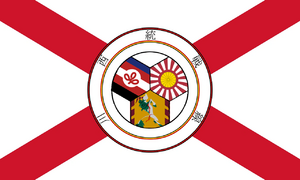Borealian United Front: Difference between revisions
No edit summary |
No edit summary |
||
| Line 2: | Line 2: | ||
[[File:Borealian United Front.png|thumb|Flag of the Borealian United Front]] | [[File:Borealian United Front.png|thumb|Flag of the Borealian United Front]] | ||
The union's proposed objectives were to guarantee economic self-sufficiency, foster mutual cooperation among member states, and resist the influences of Amnisian Imperialism. However, in practice, it served primarily as a tool to enforce Tayichian hegemony over Borealia. It was also used as a propaganda tool to depict Tayichian armies as "liberators" from Amnisian influence. Following the conclusion of the Great War, the Borealian United Front garnered criticism and scorn due to its nationalist, militarist, Tayichian supremacist and racist goals. | The union's proposed objectives were to guarantee economic self-sufficiency, foster mutual cooperation among member states, and resist the influences of Amnisian Imperialism. However, in practice, it served primarily as a tool to enforce Tayichian hegemony over Borealia. It was also used as a propaganda tool to depict Tayichian armies as "liberators" from Amnisian influence. Following the conclusion of the Great War, the Borealian United Front garnered criticism and scorn due to its nationalist, militarist, Tayichian supremacist and racist goals. | ||
[[Category:Lands End]] | |||
Revision as of 13:53, 2 June 2024
The Borealian United Front (Tayichian: 川西統戦線, Kawanishi Osamu-sensen) was a pan-Borealian union established by the Empire of Tayichi. Initially, it included the three founding members of Tayichi, Syua and Qilia, but as the Great War in Borealia progressed, it included the [insert Tayichian puppet government in SBR name] and others.
The union's proposed objectives were to guarantee economic self-sufficiency, foster mutual cooperation among member states, and resist the influences of Amnisian Imperialism. However, in practice, it served primarily as a tool to enforce Tayichian hegemony over Borealia. It was also used as a propaganda tool to depict Tayichian armies as "liberators" from Amnisian influence. Following the conclusion of the Great War, the Borealian United Front garnered criticism and scorn due to its nationalist, militarist, Tayichian supremacist and racist goals.
